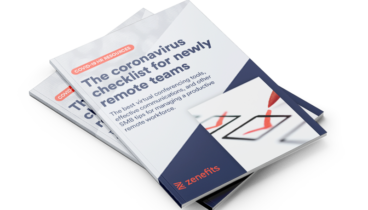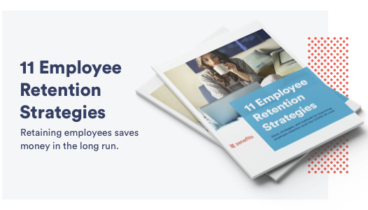For many companies, the need to hire workers hasn’t changed — but hiring processes have.

Here's what you need to know:
-
For on-site onboarding, policies and practices such as keeping the worksite sanitary and procedures for distancing will need to be incorporated
-
Don’t ditch your buddy system — for both on-site and remote workers. Online meetings should replace face-to-face communication
-
If you were planning to provide company swag to your new remote hire, mail the package
-
If remote workers are creating a home office, consider helping them set up a workplace that’s ergonomic and comfortable
-
Make sure training for remote workers has breakout times built into the system, along with Q&A
-
Schedule time daily for the first week, then weekly beyond, to simply answer your new hires’ questions. Also get feedback
-
Whenever you’re addressing the team as a whole, make sure your remote workers are included in the conversation and invited to company events
Across the country and across the globe, rush hour traffic and foot traffic are ratcheting up as we see businesses get back to work. In a COVID-19 world, things may have changed dramatically for SMBs, but they’re managing to keep up. The need to hire staff — either to replace those who aren’t returning to the job or for new positions — hasn’t changed. However, the way we go about doing so has. Remote interviews and medical clearances are the new norm in bringing on a hire. Onboarding needs to adapt, as well, to the fallout the pandemic has caused.
A Brandon Hall Group study found employees who experienced great onboarding had an 82% higher retention rate than those who didn’t.
Onboarding new hires has always been an important step to convert new hires into long-term employees. Rather than drop a new staffer into the mix and hope they find a home, onboarding welcomes them into the work, the culture, and the team. A Brandon Hall Group study found employees who experienced great onboarding had an 82% higher retention rate than those who didn’t. For all the time and expense allocated to each new hire, retention is a key metric. The small amount of time and resources it takes to onboard successfully could significantly reduce the amount of time and resources wasted later to rehire a promising new staffer who didn’t make the transition.
Onboarding — on-site and virtual
As we move forward, businesses may need to create 2 models for onboarding:
- Your on-site onboarding process will likely need a few tweaks to adapt with the times
- Virtual onboarding may be completely new to your organization. It will be important to follow best practices for both means of assimilating new hires
On-site onboarding adaptation
You may have an onboarding program already in place for on-site hires, but it will need to shift slightly in today’s environment. The addition of these policies and practices will need to be incorporated into your onboarding protocols:
- Keeping the worksite sanitary
- Reminding employees to stay home when sick
- New procedures for distancing and other accommodations
In the past, creating a buddy system for new hires meant scheduling frequent meetings and lunch dates to establish a relationship with the newest in the fold. The way we connect may have shifted to a virtual environment, but the need remains. Online meetings should replace face-to-face communication, so don’t just eliminate them. Your new hire still needs a sounding board, a resource, and a confidant — even if it’s not in person.
Start with a review of your on-site onboarding program to find ways you’ll need to adapt, post-COVID-19. Then incorporate any new policies and protocols to the mix. Not only will you help your new hire assimilate faster, they’ll be more comfortable knowing you have established protocols in place to protect them as much as possible.
Start with a review of your on-site onboarding program to find ways you’ll need to adapt, post-COVID-19. Then incorporate any new policies and protocols to the mix.
Virtual onboarding
For many companies, the shift to remote workers was sudden but proved to be a workable solution. As they add more staff, adding more remote workers became a logical way to staff up and raise productivity. But not everyone has considered how to onboard remote workers successfully.
Look at your onboarding plan for on-site workers and adapt from there. Just because a staffer isn’t on premises doesn’t mean they don’t need a buddy to guide them through the first stages of employment. It all begins with welcoming processes.
Welcome aboard!
Before day one, you were likely planning to provide company swag to your new hire. Nothing says welcome aboard like coffee mugs, t-shirts, and office gadgets that boast your team. You’ll want to make that same first impression on remote hires. Just mail the package (and maybe ask that they don’t open it until they start their first call with you!) so it’s there for their first day. A little advanced planning is all that’s required to say “Welcome to the team!”
Schedule the same meetings, virtually, with remote new hires as you would with on-site staff:
- Human Resources to discuss policies and benefits
- IT for setups and passwords
- Accounting to discuss payroll, etc
If you’re assigning a buddy to the new hire, virtual lunch on the first day works well. Send the new staffer a gift card for delivery in their area and have your in-house staffer meet online while they both nosh. Don’t forget to schedule follow-up chats frequently to see how things are going.
The traditional walk through of the office will be replaced by a virtual one, but it’s just as important, if not more so, for remote workers. Putting a face to the voices on the phone will help them more easily become part of the team. If you normally have workers send a “welcome” email to new hires, consider asking them to do a video version.
Making work workable
Some new remotes will want to work from shared workspace locations to have access to a range of office equipment and supplies. Be prepared to pay the monthly fees, if any. If you’re hiring remote workers around the country you may be able to find national organizations that provide discounted rates for multiple workers. Local work share companies may do so, as well, if you’re hiring from a specific zip code.
If workers are setting up an office in their home, you’ve probably already determined whether the worker will be using their own equipment or if you’re shipping laptops and cell phones their way. In either case, you’ll need to onboard them with using the hardware and software they’ll need to work well. If you’re offering any stipend to offset their costs for equipment or phone lines, make sure to include that information in the onboarding process as well as how they are reimbursed.
A best practice goes beyond the nuts and bolts and helps the new hire set up a workplace at home that’s ergonomic and comfortable. There are companies that specialize in ergonomic assessments and recommendations. You may find a small investment in an adjustable office chair today reaps a great return on productivity in the future. If you can’t find someone to go to their home, there are online resources you can point them to; just make sure you allow them some time on the clock to get set up comfortably.
Training from afar
Training is key to getting every new hire up to speed. For remote workers, it’s essential. Setting up time for training is critical — spacing training may be even more so. Remember that your remote staffer won’t be in the room with the trainer, so they’ll be less likely to ask for restroom breaks, yawn to indicate they need a stretch, or get a chance to warm their coffee.
Make sure your training has breakout times built into the system, along with Q&A. Depending on the complexity of the material, you’ll want to stop periodically to make sure the new hire understands the information, has had time to take notes, and/or ask questions.
Constant communication
The more time you invest today, the more time they’ll stay.
Make time to talk! New hires have tons of questions, and while you’re not fielding “Where’s the bathroom?” on day one, they’ll have more. Schedule time daily for the first week, then weekly beyond, to simply answer their questions. Use this time to also get feedback on the onboarding process or address any concerns. The more time you invest today, the more time they’ll stay.
Keeping inclusion top of mind
Don’t forget team time and extracurriculars. Your remote workers may not be a member of the company softball team if they’re in another time zone, but team meetings and celebrations, office parties, after-hours events, and other social gatherings should always include them. They may not be able to attend, but make sure the invitation has been made. Whenever you’re addressing the team as a whole, make sure they’re in on the conversation — especially when you’re handing out kudos!
Finally, make note of your new processes; be prepared to change what isn’t working and build on what is. This may be new territory for your company, so there’ll likely be some bumps in the road. Document the process (so it’s easier the next time) and be ready to adjust as needed. As the world continues to shift to the remote model, the changes you make today will serve you well in the future.







